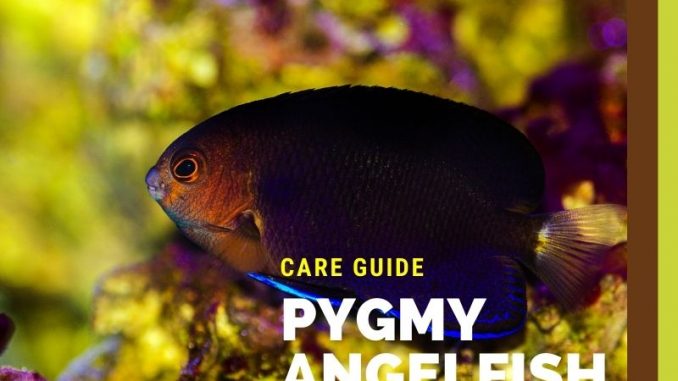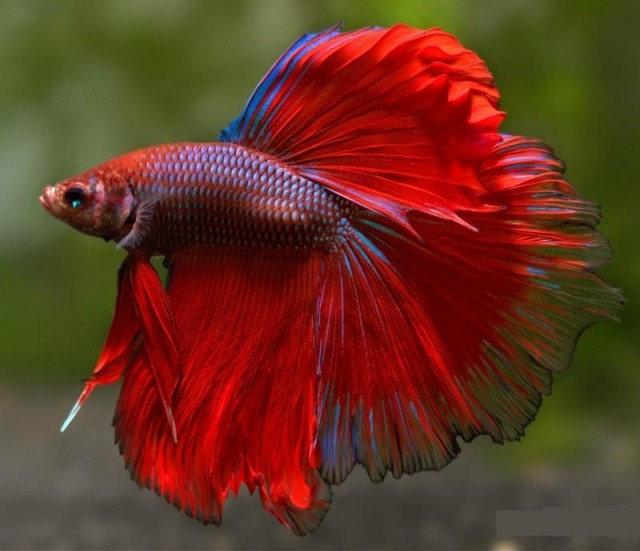Pygmy Angelfish Care & Species Overview

The Pygmy Angelfish, often known as the Cherub Angelfish, the Cherubfish, Pygmy Dwarf Angelfish, the Atlantic Pygmy Angelfish, or the Atlantic Pygmy, is a head-turning saltwater fish that has been gaining extra reputation within the aquarium passion.
With their intense blue and orange hue, these small angelfish actually stand out in a group saltwater tank. Nice for a FOWLR (Fish Solely with Dwell Rock) tank, Pygmy Angelfish will also be utilized in reef tanks (with warning–they aren’t utterly reef-friendly but in addition not 100% contraindicated.
Like most of the semi-aggressive fish I write about, aggression may be considerably managed by decreasing threats and stress, however all the time take care when including them to a group tank.
On this information, I’ll cowl correct take care of Pygmy Angelfish, together with some details about their background, learn how to handle their aggressive nature, arrange the most effective habitat and weight-reduction plan.
Pygmy Angelfish Info & Overview
| Class | Ranking |
| Care Degree: | Reasonable |
| Temperament: | Semi-aggressive |
| Colour Type: | Blue & orange |
| Lifespan: | 5 years |
| Dimension: | 3 inches |
| Food regimen: | Omnivore |
| Household: | Pomacanthidae |
| Minimal Tank Dimension: | 55 gallons |
| Tank Set-Up: | Saltwater (reef with care) |
| Compatibility: | Peaceable group |
Pygmy Angelfish, scientific title Centropyge argiare, are native to a big swath of ocean, from the Gulf of Mexico and the Western Atlantic, and alongside the Bahamas, the Caribbean, Florida, and French Guiana.
Recognizable by their vibrant sapphire physique and orange highlights, they have been first described in 1951 by Woods and Kanazawa. As a result of they spawn in captivity, hobbyists are capable of get them for his or her dwelling communities with out threatening coral reefs.
They’re fairly skittish attributable to their small dimension, in order that they recognize hiding locations like caves and driftwood. Within the wild, they’re seen at a variety of depths, from 16 to 148 toes (5 to 45 m).
Typical Conduct
Pygmy Angelfish are feisty creatures that can scuffle with different species and one another. I like to recommend no a couple of male per tank, as a number of males will seemingly end in elevated territorialism. Nonetheless, attaining this objective may be powerful because it’s almost unattainable to inform which angelfish are feminine and that are male.
Aggression can actually enhance throughout mating time, so in case you are planning on breeding them, prepare for a battle.
A method that you may scale back aggression amongst Cherub Angelfish (admittedly, their title is a misnomer) is by offering intensive house and beneficiant caves and hiding areas. If every angelfish is ready to lay declare to their very own territory, their probability of aggression will lower.
This additional house may also assist scale back aggression with different species, as feeling threatened is one cause Pygmy Angelfish lash out–they’re solely 3 inches (5 cm), in spite of everything, and will simply function third breakfast for a bigger, extra aggressive fish.
All that being mentioned, I might be remiss if I didn’t point out that when Pygmy Angelfish do exhibit aggression, they are going to struggle to the loss of life, whether or not meaning killing one other species or certainly one of their very own and even going through their very own loss of life.
Pygmy Angelfish are sensible and conscious of outside-the-tank happenings. You’ll discover that they’re listening to you as you method the tank, and also you would possibly even see them increase their dorsal fin, prepared for a throwdown.
These are lively fish that can dart across the tank, displaying off their would possibly and good coloration.
Look
I’ve already detailed the sapphire blue and orange colour sample of the Pygmy Angelfish; additionally they have distinctive blue rings across the eye space.
Like different dwarf angelfish, Cherub Angelfish have elongated our bodies and rounded fins.
They appear to be mini variations of bigger angelfish, making them much more enjoyable to observe them darting across the tank. And due to their smaller dimension, you’ll be able to benefit from the look of the angelfish with out the actual property dedication of a 200-plus gallon tank.
Differentiating between the sexes
Other than the truth that male Pygmy Angelfish could also be barely bigger than feminine Pygmy Angelfish, there isn’t any sure-fire sign of gender. In truth, all Pygmy Angelfish are born feminine, and essentially the most dominant fish will turn out to be male.
If the dominant male dies or is killed, the subsequent within the pecking order will flip right into a male. You possibly can see why there may be probably not a great way to find out intercourse from bodily traits.
Though the males in some fish species exhibit extra intense coloration than the females, there isn’t any distinction in colour between feminine and male Cherub Angelfish.
Habitat and Tank Circumstances
As a result of they typically really feel harassed and threatened, you wish to be sure to supply them loads of hiding locations, together with caves and reside rocks.
A FOWLR setup is good for them–there isn’t any coral to kill and they’ll eat the algae that gather on the reside rock. The time period reside rock may be complicated for those who haven’t heard it earlier than. Dwell rock just isn’t truly alive however comes from the skeletons of beforehand alive coral.
FOWLR aquascapes are nice for saltwater fish that aren’t reef protected. Pygmy Angelfish should not reef-unfriendly, however they’re additionally not absolutely reef-friendly. You would put them in a reef aquascape, however they are going to nip at coral.
Pygmy Angelfish are center to backside dwellers and can settle across the reside rock for those who present it.
Water Circumstances
Pygmy Angelfish should not tremendous choosy about their water chemistry, however it is best to guarantee a clear tank. Do 25 or 30% partial water adjustments each month, or 15% each different week. Carry out common water adjustments to make sure low nitrate and ammonia ranges.
Optimum water parameters for Pygmy Angelfish:
- pH ranges: 8.1 to eight.4
- Water hardness: 8 to 12 dKH
- Water temperature: 72°F – 82°F (22°C – 28°C)
What Dimension Aquarium Do They Want?
You want not less than a 55-gallon tank (208 liters) for Pygmy Angelfish. In the event you’re making an attempt to deal with multiples, go bigger. They’re extra aggressive after they don’t have copious quantities of house.
Tank Mates
Keep away from peaceable, calm, small fish with Pygmy Angelfish. The previous will simply get bullied and certain destroyed. They shouldn’t trouble massive invertebrates however will eat smaller invertebrates. They’re neither really helpful nor prohibited for reef tanks, however if in case you have a reef aquascape, you ought to be ready for Pygmy Angelfish to nibble on corals.
Protecting Pygmy Angelfish Collectively
As I’ve talked about, there may be important infighting amongst Pygmy Angelfish, significantly between males, so for those who can inform the distinction between the men and women, restrict the variety of males to 1. If in case you have a couple of, there’s an excellent likelihood you’ll find yourself with one anyway after they get in a struggle to the loss of life.
In the event you’re not breeding them, I’d suggest simply having one in a tank to restrict the potential massacre. In the event you do preserve multiples, be sure they’ve ample house to say territory.
Food regimen
Pygmy Angelfish are omnivores, in order that they want a different weight-reduction plan of protein and greens. They may exist on marine algae for almost all of their diet, however additionally they like ready angelfish meals and frozen meaty proteins like brine shrimp and Mysis shrimp. You possibly can attempt a nori lettuce clip or spirulina algae.
If in case you have a FOWLR aquascape, your Pygmy Angelfish will snack on reside rocks between their day by day feedings.
It’s best to feed them small parts 3 instances a day. In the event you feed an excessive amount of in a single sitting, you’ll find yourself with additional meals waste, which can compromise the cleanliness of your tank. Feed solely what your Pygmy Angelfish can eat in about 3 minutes.
Care
Pygmy Angelfish are vulnerable to the identical ailments that almost all saltwater creatures are. Liable to parasitic infections resembling marine ich (or ick) and velvet, Pygmy Angelfish ought to be quarantined and handled instantly for those who see white, yellow, or gray spots and/or intensive itching.
Each ich and velvet are tremendous contagious, and when not handled promptly, may be deadly. Select copper-free variations of the remedy treatment.
Along with parasites, Pygmy Angelfish are, sadly, liable to bacterial infections attributable to their proclivity for combating. In the event that they spar with different species or different Pygmy Angelfish and are wounded, you’ll have to watch them for an infection.
In fact, bacterial infections may happen when the pores and skin integrity is compromised by the ich and velvet parasites.
Lastly, fungal infections are sometimes secondary results of parasitic infections. The most effective prevention for all these ailments is a clear tank. Test water commonly and carry out partial adjustments when indicated. And once you witness extreme combating or bullying, separate the fighters or take away one.
Breeding
If you’re up for a dominance battle, you’ll be able to go forward and attempt to breed Pygmy Angelfish. All Pygmy Angelfish accessible within the aquarium commerce are bred in captivity, so it may be finished, however not with out some infighting. Moreover, elevating the larvae will also be difficult.
You’ll keep in mind from an earlier part of this information that Pygmy Angelfish are protogynous hermaphrodites; that’s, they’re all born feminine after which the dominant fish turns right into a male. In the event you’re making an attempt to breed, begin by placing a bigger Pygmy Angelfish with a smaller one, hoping one will tackle the male position in a number of months. In the event you select this selection, control the smaller fish to ensure they’re protected from the bigger ones.
Alternatively, you might put a smaller group of Pygmy Angelfish into your tank and allow them to struggle it out for the male dominance position. Be ready for a bloody battle. Since Pygmy Angelfish practices harem breeding, this latter methodology is good.
In the event you’re capable of make it previous the male/feminine problem and the infighting, you’ll seemingly see fertilized eggs, that are launched by the men and women into the water present, so that you’ll want a taller tank.
In just below a day, the eggs will hatch and the tiny larvae stay within the yolk sac for two or 3 days. It is a time throughout which you will have to feed them microscopic algae, which isn’t a straightforward activity.
For a tip: If the aggression is basically intense between two of the Pygmy Angelfish, likelihood is good that you just even have two males.
Are Pygmy Angelfish Appropriate on your Aquarium?
Pygmy Angelfish are one of the vital putting and intensely coloured saltwater fish that you just’ll encounter. In the event you’re as much as the problem of mitigating their aggressive tendencies, Pygmy Angelfish might be an excellent match on your saltwater group.
If in case you have or are planning a FOWLR aquascape, Pygmy Angelfish is suited to this surroundings. Though they aren’t utterly reef unsafe, for those who do select to place a Pygmy Angelfish in a reef setting, be warned that also they are not utterly reef protected, and will very effectively munch on coral.
It’s laborious to withstand their lovely colours, although.
Do you assume Pygmy Angelfish are too aggressive for a group aquarium? I’d love to listen to about your experiences with them.









